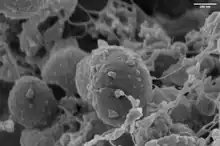| Haloferax | |
|---|---|
 | |
| SEM image of Haloferax mediterranei. | |
| Scientific classification | |
| Domain: | |
| Kingdom: | |
| Phylum: | |
| Class: | |
| Order: | |
| Family: | |
| Genus: | Haloferax Torreblanca et al. 1986[1] |
| Type species | |
| Haloferax volcanii (Mullakhanbhai & Larsen 1975) Torreblanca et al. 1986 | |
| Species | |
|
See text | |
In taxonomy, Haloferax (common abbreviation: Hfx.) is a genus of the Haloferacaceae.[2]
Genetic exchange
Cells of H. mediterranei and cells of the related species H. volcanii can undergo a process of genetic exchange between two cells which involves cell fusion resulting in a heterodiploid cell (containing two different chromosomes in one cell).[3] Although this genetic exchange ordinarily occurs between two cells of the same species, it can also occur at a lower frequency between an H. mediterranei and an H. volcani cell. These two species have an average nucleotide sequence identity of 86.6%.[3] During this exchange process, a diploid cell is formed that contains the full genetic repertoire of both parental cells, and genetic recombination is facilitated. Subsequently, the cells separate, giving rise to recombinant cells.
Taxonomy
As of 2022, 13 species are validly published under the genus Haloferax.[1]
- Proposed species
Several species and novel binomial names have been proposed, but not validly published.
- "Haloferax antrum" Enache et al. 2006,[4] "Haloferax opilio" Enache et al. 2006, "Haloferax rutilus" Enache et al. 2006 and "Haloferax viridis" Enache et al. 2006 were isolated from Romanian salt lakes and first proposed as new species in 2006.[5] Only H. prahovense, that was proposed along them has since been validly published.
- "Haloferax berberensis" Kharroub et al. 2005e was isolated in Algeria and proposed as new species in 2005.[6]
- Haloferax litoreum, Haloferax marinisediminis and Haloferax marinum were first published in 2021, but are not accepted as of 2022.[7]
- Haloferax marisrubri and Haloferax profundi were first published in 2020, but is not accepted as of 2022.[8]
- Haloferax massilisiensis or Haloferax massiliense was first published in 2016 and again in 2018 as human associated halophilic archaeon. As of 2022, this species is not accepted.[9]
Phylogeny
The currently accepted taxonomy is based on the List of Prokaryotic names with Standing in Nomenclature (LPSN)[1] and National Center for Biotechnology Information (NCBI).[2]
| 16S rRNA based LTP_06_2022[10][11][12] | 53 marker proteins based GTDB 08-RS214[13][14][15] | ||||||||||||||||||||||||||||||||||||||||||||||||||||||||||||||||||||||||||||||||||||||||||||||||||||||||||||||||||||||||||||||||||||||||||||||||||||||||||||||||||
|---|---|---|---|---|---|---|---|---|---|---|---|---|---|---|---|---|---|---|---|---|---|---|---|---|---|---|---|---|---|---|---|---|---|---|---|---|---|---|---|---|---|---|---|---|---|---|---|---|---|---|---|---|---|---|---|---|---|---|---|---|---|---|---|---|---|---|---|---|---|---|---|---|---|---|---|---|---|---|---|---|---|---|---|---|---|---|---|---|---|---|---|---|---|---|---|---|---|---|---|---|---|---|---|---|---|---|---|---|---|---|---|---|---|---|---|---|---|---|---|---|---|---|---|---|---|---|---|---|---|---|---|---|---|---|---|---|---|---|---|---|---|---|---|---|---|---|---|---|---|---|---|---|---|---|---|---|---|---|---|---|---|---|---|
|
|
See also
References
- 1 2 3 J.P. Euzéby. "Haloferax". List of Prokaryotic names with Standing in Nomenclature (LPSN). Retrieved 2023-10-10.
- 1 2 Sayers; et al. "Haloferax". National Center for Biotechnology Information (NCBI) taxonomy database. Retrieved 2023-10-10.
- 1 2 Naor A, Lapierre P, Mevarech M, Papke RT, Gophna U (August 2012). "Low species barriers in halophilic archaea and the formation of recombinant hybrids". Curr. Biol. 22 (15): 1444–8. doi:10.1016/j.cub.2012.05.056. PMID 22748314.
- ↑ EBA - European Nucleotide Archive, retrieved 2022-07-14
- ↑ NCBI Taxonomy browser (Haloferax antrum), retrieved 2022-07-14
- ↑ NCBI Taxonomy browser (Haloferax berberensis), retrieved 2022-07-14
- ↑ "LPSN - List of Prokaryotic names with Standing in Nomenclature". Deutsche Sammlung von Mikroorganismen und Zellkulturen. Retrieved 2022-07-14.
- ↑ "LPSN - List of Prokaryotic names with Standing in Nomenclature". Deutsche Sammlung von Mikroorganismen und Zellkulturen. Retrieved 2022-07-14.
- ↑ "LPSN - List of Prokaryotic names with Standing in Nomenclature". Deutsche Sammlung von Mikroorganismen und Zellkulturen. Retrieved 2022-07-14.
- ↑ "The LTP". Retrieved 10 May 2023.
- ↑ "LTP_all tree in newick format". Retrieved 10 May 2023.
- ↑ "LTP_06_2022 Release Notes" (PDF). Retrieved 10 May 2023.
- ↑ "GTDB release 08-RS214". Genome Taxonomy Database. Retrieved 10 May 2023.
- ↑ "ar53_r214.sp_label". Genome Taxonomy Database. Retrieved 10 May 2023.
- ↑ "Taxon History". Genome Taxonomy Database. Retrieved 10 May 2023.
Further reading
- Oren A, Ventosa A (2000). "International Committee on Systematic Bacteriology Subcommittee on the taxonomy of Halobacteriaceae. Minutes of the meetings, 16 August 1999, Sydney, Australia". Int. J. Syst. Evol. Microbiol. 50 (3): 1405–1407. doi:10.1099/00207713-50-3-1405. PMID 10843089.
- Torreblanca M, Rodriquez-Valera F, Juez G, Ventosa A, Kamekura M, Kates M (1986). "Classification of non-alkaliphilic halobacteria based on numerical taxonomy and polar lipid composition, and description of Haloarcula gen. nov. and Haloferax gen.nov". Syst. Appl. Microbiol. 8 (1–2): 89–99. doi:10.1016/s0723-2020(86)80155-2.
- Gibbons, NE (1974). "Family V. Halobacteriaceae fam. nov.". In RE Buchanan; NE Gibbons (eds.). Bergey's Manual of Determinative Bacteriology (8th ed.). Baltimore: The Williams & Wilkins Co. ISBN 0-683-01117-0.
- PubMed references for Haloferax
- PubMed Central references for Haloferax
- Google Scholar references for Haloferax